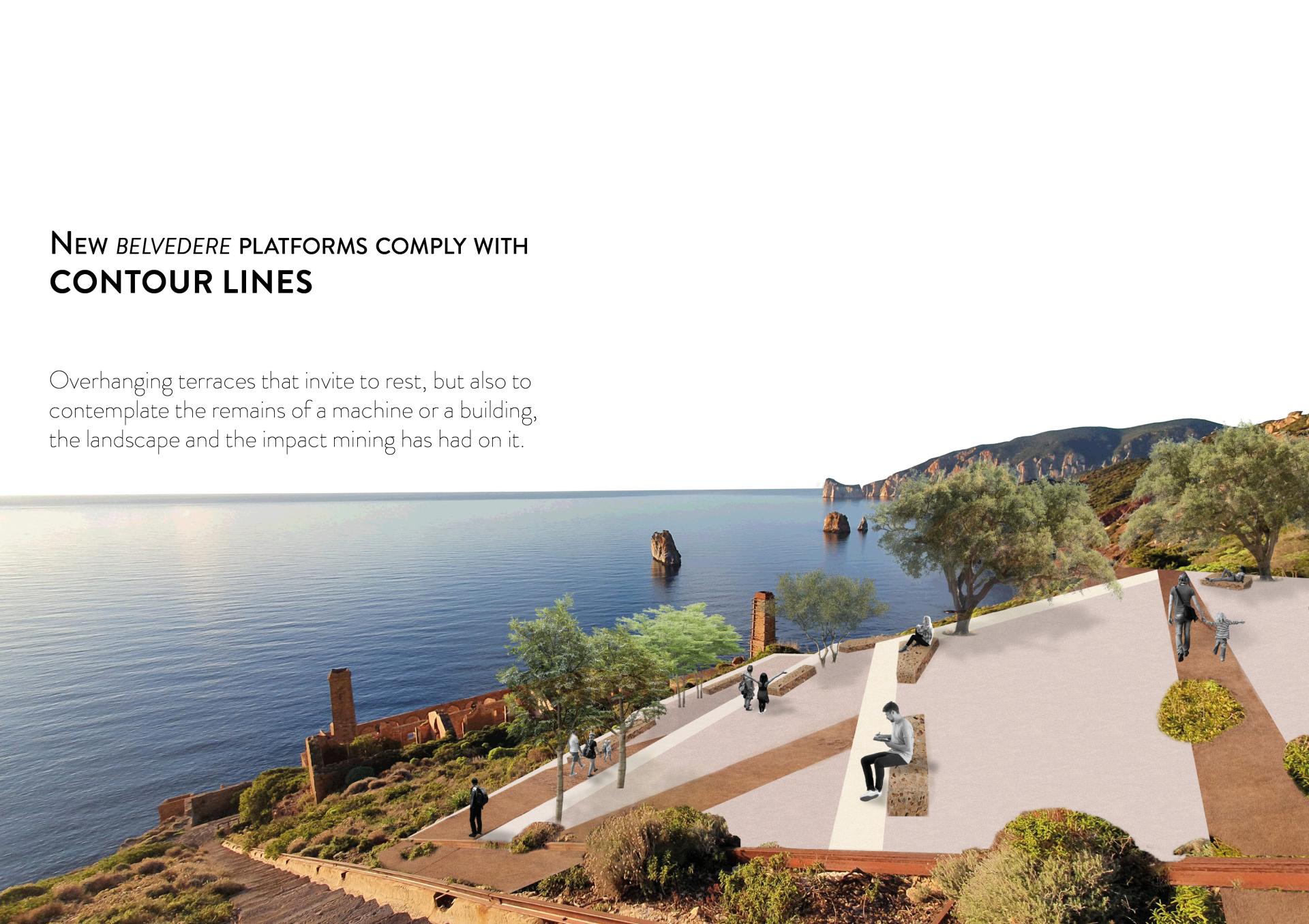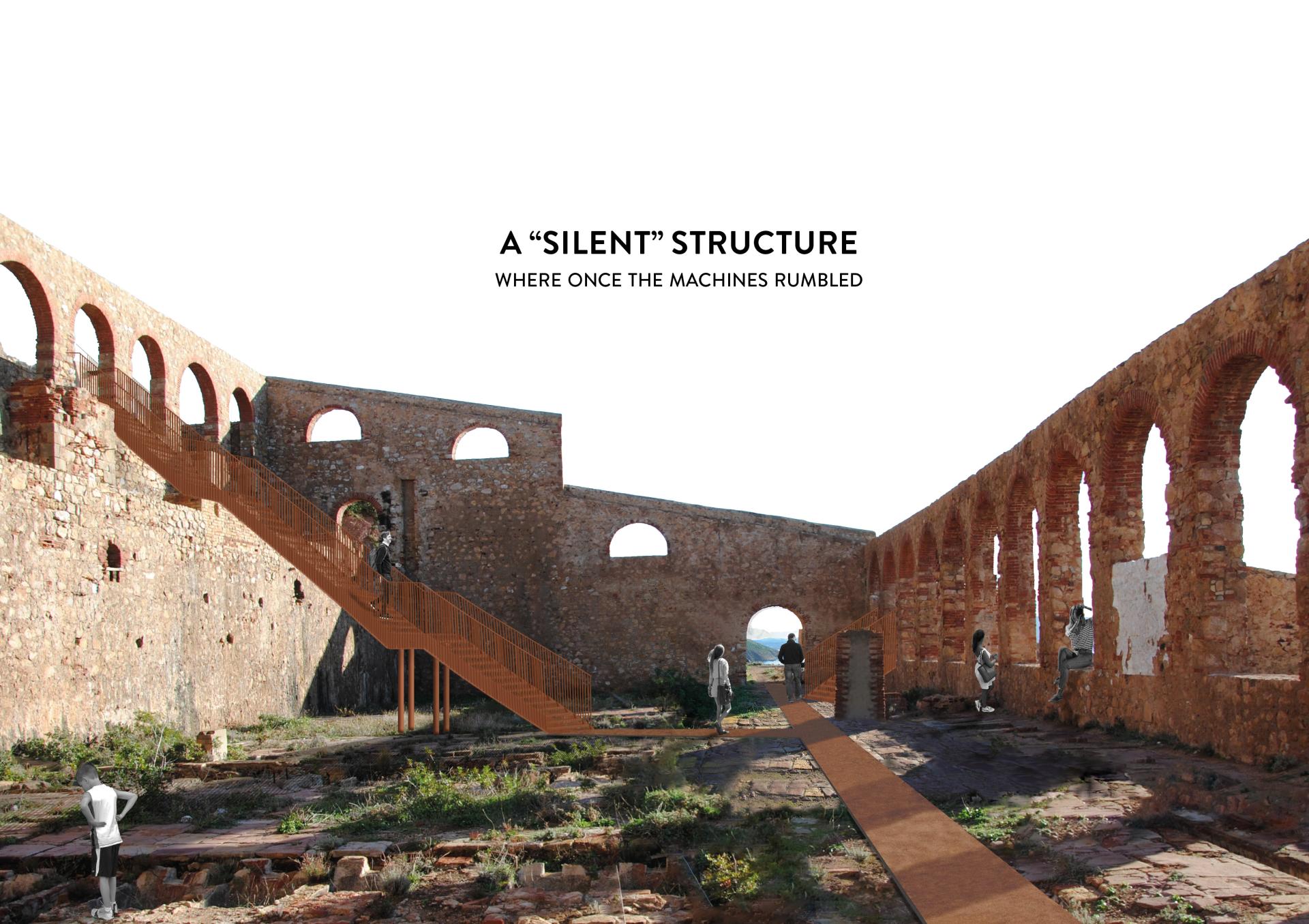On the trails of minerals
Basic information
Project Title
Full project title
Category
Project Description
Suspended on a rocky promontory overlooking the sea on the coast of Sardinia, Laveria Lamarmora is an architectural complex designed according to the production process of the Nebida mine. The aim of the project is to create a new accessible public space and to prefigure a model of "silent intervention" for the regeneration of the abandoned mining landscapes of Sardinia. An open-air museum, which stages the mine in its condition of ruin and makes the traces of the past readable in the landscape.
Geographical Scope
Project Region
Urban or rural issues
Physical or other transformations
EU Programme or fund
Which funds
Description of the project
Summary
Laveria Lamarmora, set in the purplish rock of Nebida coast, could be considered an open-air museum in itself. Its condition of ruin, generated by decades of decay due to lack of use, gives it a sense of timelessness. The absence of the roofing, which leaves the plan and the structure on display, and the permanent traces of the mining work, scattered on the surrounding landscape, reveal the shape and pattern of this articulated system, and become the premise of a project proposal aimed at making legible the meaning and the history of these places. The goal is to reconnect the Laveria Lamarmora conceptually, visually and physically to the village of Nebida and to the mining sites of the surroundings, to allow it to be rediscovered and ensure its safe fruition. A path of intersection between old and new is proposed: a modern layer that does not erase but highlights the traces of the existing, does not rebuild but make the history of Laveria and its flows readable. The new promenade starts from the entrance of the village and retraces the miners' road on discontinuously paved paths, which allow the conformation and materiality of the landscape to emerge. These paths are supported by ramps and stairways where the terrain is steeper and are integrated with existing services and new auxiliary structures. The project involves the construction of a series of Belvedere for rest and contemplation of the landscape located along the trail and in correspondence with significant elements which reflect the very concept of the architecture of the Laveria, intersecting the rocks and the existing vegetation and creating a system of overhanging terraces, which comply with the orography of the land, softening their geometric shapes at times. The idea is to recycle and regenerate the landscape in the spirit of minimal intervention, generating almost invisible systems that feed on pre-existing structures and celebrates them through architectural gestures in harmony with the landscape.
Key objectives for sustainability
The project tries to adapt as much as possible to the existing, including the orography, allowing the iconic geology of the place to stand out. Following the rule of minimum intervention, the aim is to recycle and regenerate, while planning an almost invisible system of paths and platforms. To make these interventions "silent" most of the new elements are conceived in natural materials, collected on site, with neutral colours or that recall the nuances of the context. Thus, the paths are paved in a discontinuous way with a concrete consisting of a mixture of fine gravel and rust-coloured pigments that recall the rusty remains of cables, rails and machinery, alternating with long consolidated but "bare" stretches of rammed earth. The belvedere platforms, on the other hand, are designed in a more neutral colour, to allow the chromatism of the landscape and the Laveria to emerge. The seats placed on the viewing platforms were designed in local stone, the one collapsed from the same walls of the buildings of the complex. Despite the high degree of contamination, mining sites are places of refuge for biological diversity. The deposit of extractive materials has generated an inhospitable substrate in extensive areas around the Iglesiente mines. However, numerous research on the characteristics and vegetational alterations of disused mining sites have shown that there is a flora capable of colonizing these surfaces and extracting toxic materials from the ground. As part of the Nebida promenade project, the conversion of mining landfills into testing grounds for phytoremediation techniques is proposed.
The proposal want to be a model and best practice for a sustainable regeneration of the forgotten mining landscapes of Sardinia, but also in the rest of Europe. To systematise the inversion of the process of decay the mining activity has generated, without altering their character, key actions for this type of interventions must be cleaning, selecting and maintaining.
Key objectives for aesthetics and quality
Industrial archaeology complexes as Laveria Lamarmora are not only monumental places potentially among the most attractive in Sardinia, but actual living heritages to collectivize. In Nebida we are faced with buildings that do not represent mere containers, but are carriers of contents that go far beyond the physicality of the ruins that we can observe today. The design proposal is based on the desire to recover the network of high historical and cultural value that united in a single large machine all these salient architectural and landscape facts, superimposing a contemporary layer that establishes a continuity with the past without being a mere repetition of it, but a clear and complete codification of its identifying signs. What we want to convey, in fact, is not the contingent reality of a presence that no longer has a reason to exist, but the ways in which the elements that remain should be understood. Therefore, the project for Laveria Lamarmora is a path of intersection between old and new that overlaps, without erasing, the existing traces. A scenic walk that, retracing the paths of the miners, makes the flows that were the lifeblood of this place when it was in operation once again legible. This idea is based on the conception of the landscape of the ruins as a stage for significant signs, where visitors can be spectators and actors at the same time, thanks to a script composed of traces finally made legible through formal and emotional suggestions, able to guide them in the space they go through. On the one hand, the physical presences, sometimes bulky, others monumental, of a lost functionality and massive topicality; on the other, elements of which no longer visible traces remain, but which can be evoked in the imaginary through a functional appeal adapted to contemporary use. New quality spaces, green areas and services, along with open-air activities, are the strategies envisioned to reconnect the public to these primarily natural settings.
Key objectives for inclusion
The new Promenade of Nebida wants to help creating an awareness of the past human activities that took place in these landscapes full of signs. It pours the foundation for the development of a "tourism of belonging", tourism that belongs to a place not to use it as a moment linked only to an experience, but to return memories and signs to the landscape, concrete acts of permanence that can make the space dynamic and constantly changing. Not giving a specific and unique function, Laveria Lamarmora lends itself to welcoming a variety of experiences of interaction with the place, and allows users to progressively invent other functions and share. People are therefore not to be only spectators, but also actors. Their memory and imaginary will help reading the signs scattered on the site, and it will be especially useful for the setting up of information panels and temporary exhibitions through the paths or inside the planned small structures auxiliary to the visit.
At the entrance of Nebida, we see is an abandoned football field, where once there were mine's workshops and minerals entered the old Laveria Carroccia. The project proposal suggests here to recover the field and to create a new quality public plaza, that Nebida lacks, a multipurpose space where people of all ages can gather, events can happen, and of which the old Laveria Carroccia can become the landmark, introducing to the path to Laveria Lamarmora. In an attempt to improve people's fruition, the project proposal address a problem that passers-by and enthusiasts have manifestly arose for decades when visiting the site: the need of reconnection between the village, the mine and the sea, visible in the makeshift and dangerous paths generated by human passage through the years, in order to make one's way to the system.
The design of a promenade like this introduces a new way of living and visiting the site by improving accessibility, without too many additions or alterations, and consequently low expenses.
Physical or other transformations
Innovative character
A place like Nebida, so rich in synergies between archaeological, historical, and monumental urban episodes, and in built and intangible values of the mining culture, inserted in a prestigious landscape context, must be valorized for what it represents, bringing back to light and offering the community its raison d’être. Therefore, it is important to plan an intervention that can make Laveria Lamarmora habitable in safety, a museum of itself and a public space accessible and reinvented by users who, walking through it, can rediscover the scenarios and meanings of a symbolic place of a culture, forgotten but documented and communicated through the indelible traces that its activity has drawn on the landscape.
Sustainability, quality experience and inclusion are combined in Nebida mine's refurbishment project through a seamless path of learning, experimentation and sociality. The goal of giving life back to Laveria Lamarmora is achieved through a process of reclamation of a contaminated soil and a devoted respect of the landscape. Phytoremediation makes it possible to look at the mining landfill from a new perspective: no longer an incurable landscape, destined to expand its inhospitality to the surrounding area, but an "agrarian machine of decontamination” that is designed to make processes visible and to catalyse urban regeneration processes in urban and suburban neighbourhood, a not accessible but observable place, which becomes a landscape design tool, making visible regeneration operations with high aesthetic and landscape value. "Freezing" the decay, rather than rebuilding the site as it was, allows to keep the authentic substance of this extraordinary artificial geographical constructions alive, recovering a collective sense of identity.
The result would be a mutual enrichment: the salubrity of which the land was deprived by human activity would be reestablished, while a salubre anthropogenic landscape in harmony with nature would be restored for the people.






